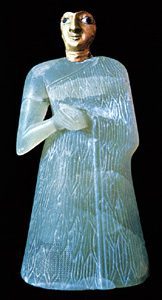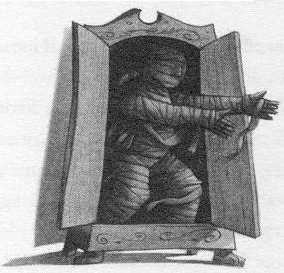 Dreams guide us to the necessary past, to the history we need to know and use. Dreams may also trigger and direct specific lines of research, as in the case of an archaeologist whose dreamed the solution to a mystery.
Dreams guide us to the necessary past, to the history we need to know and use. Dreams may also trigger and direct specific lines of research, as in the case of an archaeologist whose dreamed the solution to a mystery.
In 1883, Assyriologist Herman Hilprecht was writing a report on findings from the temple of Bel at Nippur, working from sketches made by members of the University of Pennsylvania’s excavation crew. Two fragments of agate dug up from the temple ruins had eluded exact identification; the best guess of the archaeologists who had found them was that they were from ancient “rings”. Hilprecht was not satisfied with this theory. After poring over the page proofs of his report, he went to bed and “dreamed the following remarkable dream”:
A tall, thin priest of the old, pre-Christian Nippur, about forty years of age, and clad in a simple abba, led me to the treasure chamber of the temple, on its south-east side. He went with me into a small, low-ceilinged room, without windows, in which there was a large wooden chest, while scraps of agate and lapis-lazuli lay scattered on the floor. He then addressed me as follows:
“King Kurigalzu once sent to the temple of Bel, among other articles of agate and lapis-lazuli, an inscribed votive cylinder of agate. Then we priests suddenly received the command to make for the statue of the god Ninib a pair of earrings of agate. We were in great dismay, since there was no agate as raw material at hand. In order to execute the command there was nothing for us to do but cut the votive cylinder into three parts, thus making three rings, each of which contained a portion of the original inscription. The first two rings served as earrings for the statue of the god; the two fragments which have given you so much trouble are portions of them. If you will put the two together, you will have the confirmation of my words. But the third ring you have not yet found in the course of your excavations, and you will never find it.”
With these words, he vanished.
When he woke from this dream, Hilprecht pulled out the sketches again, and now saw that the fragments could possibly be fitted together to make a section of a votive cylinder whose inscription he rendered in English as follows:
To the god Ninib, son of Bel, his lord, Kurigalzu, pontifex of Bel, presented this.
When he described them this way in his revised report, other archaeologists were skeptical, pointing out that in the drawings, the pieces of agate were of different colors. When Hilprecht was invited to the ImperialMuseumin Constantinople, which held the originals, the museum director listened to his dream with more respect than the American academics. Since it had not been understood that the pieces of agate might be connected, they had been placed in different cases. When they were extracted and pieced together, Hilprecht’s dream was confirmed. The inscription could now be read. The reason one fragment was mostly grey and the other veined with white was that an ancient stonecutter had divided an agate mass along a natural vein in its coloration. As the professor summed it up in his period English, “As soon as I found the fragments and put them together, the truth of the dream was demonstrated ad oculos.”
This was not Hilprecht’s first dream discovery. Ten years earlier, when working on a translation of the Nebuchadnezzar Stone for his dissertation, he had been guided in a dream to change the consensus interpretation.
It is worth noting that the ancient Assyrians not only had a keen interest in dreams, but had an active practice of dream travel. Dream reports from ancientAssyriasometimes describe how a dream visitor enters a space like a “zephyr”, passing through the crack of a door to enter a sleeper’s psychic space.
The Hilprecht story offers important lessons. We see that dreaming is a discipline.We get better at it through practice. Hilprecht’s prior experience of dreaming his way to the solution of a scholarly problem helped to prepare him to work with dream guidance on the agate conundrum.
We also see that dreams, like chance, favor the prepared mind. Hilprecht’s dream revelation came after a late night of intensive research; wittingly or unwittingly, he had set a focus for his dreaming.
We observe that the ancestors reach to us in dreams, and that we attract different dream guides according to our passions and our challenges.

